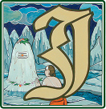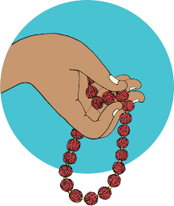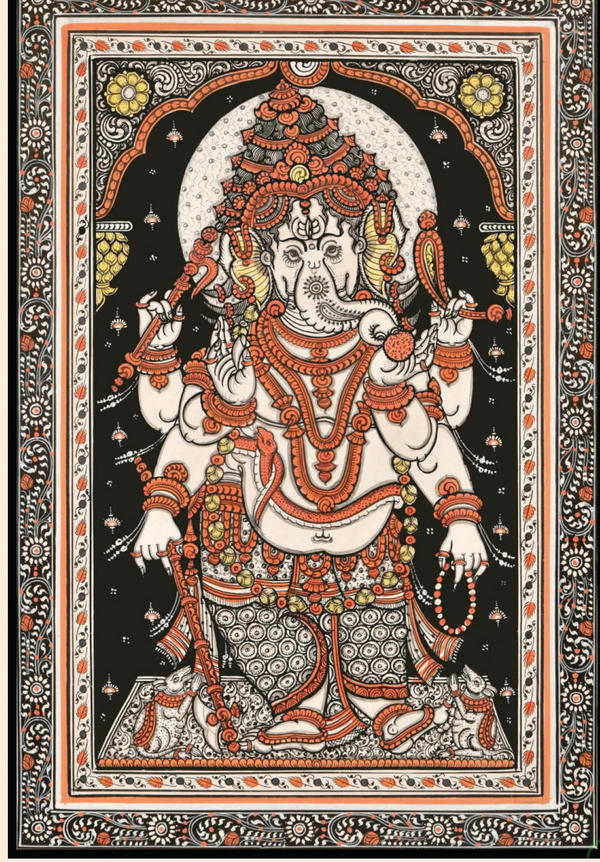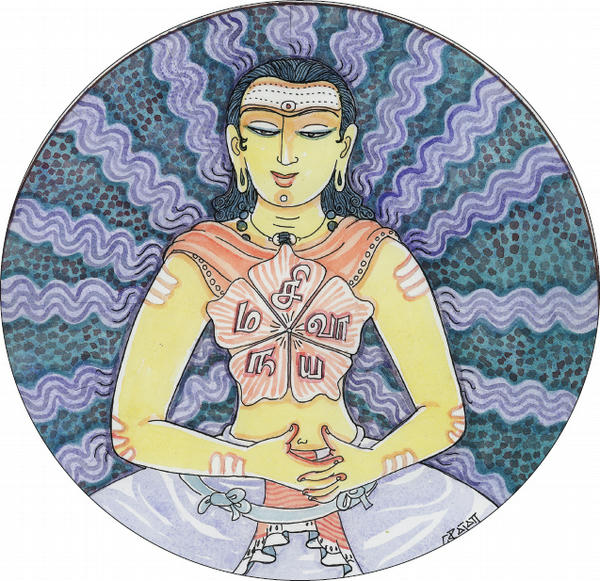Mantra Recitation§
Japaḥ§
जपः§
 APA, OR RECITATION, IS THE SPIRITUAL PRACTICE OF DEVOTEDLY REPEATing a mantra, generally a specified number of times, such as 108, often while counting on a strand of beads, called a japa mālā, while conscientiously concentrating on the meaning of the mantra. The repetition should be dutifully slow. This brings puṇya, merit, to the devotee. It should not be thoughtlessly mechanical or the hurried, so-called rapid-fire or machine-gun japa, which demonstrate ignorance of the tantras. Such casual, nonchalant negligence and disregard for contemplative traditions brings pāpa, demerit, to the devotee, creating internal strife, community opposition and turmoil for all concerned.§
APA, OR RECITATION, IS THE SPIRITUAL PRACTICE OF DEVOTEDLY REPEATing a mantra, generally a specified number of times, such as 108, often while counting on a strand of beads, called a japa mālā, while conscientiously concentrating on the meaning of the mantra. The repetition should be dutifully slow. This brings puṇya, merit, to the devotee. It should not be thoughtlessly mechanical or the hurried, so-called rapid-fire or machine-gun japa, which demonstrate ignorance of the tantras. Such casual, nonchalant negligence and disregard for contemplative traditions brings pāpa, demerit, to the devotee, creating internal strife, community opposition and turmoil for all concerned.§
Japa is a form of devotional worship, invocation, supplication, praise, adoration, meditation and direct, experiential communion. Unless we are actually in a state of samādhi (total absorption), which is rare for most people, japa provides a means to disengage from our racing thoughts and our memories of the past—mostly the bad ones. The repetition of positive, uplifting, spiritual mantras over and over again lifts consciousness and causes the mūlādhāra chakra to spin clockwise. We feel uplifted. Life does not look so bad, and neither does the past. A sense of forgiveness comes and the future looms bright. The past is forgiven and forgotten.§
The power of thought and mind is embodied in sound form, that is, in the Word. The ancient ṛishis made this knowledge of the Word into a science and turned their minds toward the inner worlds, invoking the beings therein and offering their thoughts to the Deities and devas through Vedic hymns, prayers and mantras. According to the Vedas, the holy scripture that forms the basis of Hinduism, out of the mind of the Deity came the Word, vāk. Its evolutes precede and give rise to the forms of the inner mind—the astral forms. These subtle forms in turn give rise to the outer, material forms that we see.§
By that Word of His, by that Self, He
created all this, whatever there is.§
Śukla Yajur Veda, Śatapatha Brāhmaṇa
10.6.5.5. The Vedic Experience p. 106§
This [in the beginning] was only the Lord of the universe.
His Word was with Him. This Word was His second. He
contemplated. He said, “I will deliver this Word so that
she will produce and bring into being all this world.Ӥ
Sāma Veda, Tāṇḍya Mahā Brāhmaṇa
20.14.2. Vedic Experience p.107§
The Word is infinite, immense, beyond all this.… All the
Gods, the celestial spirits, men and animals live in the
Word. In the Word all the worlds find their support.§
Kṛishṇa Yajur Veda, Taittirīya Brāhmaṇa
2.8.8.4. The Vedic Experience p.107§
The Vedic view brings increasing confirmation that modern physics is on the right track. Quantum electromagnetic field theories tell us that, in fact, there is no such thing as matter. There are only force fields of time and space that are observable as varying intensities. Thus, a carbon atom is not a bit of matter; it is a time-space-energy force field of a particular intensity.§
Nuclear physicists can change the energy force fields in a chamber and transform one element into another. If we knew the carbon mantra and could say it properly, we would cause the particular time-space-energy force field to act and some carbon would precipitate. Certain occult practitioners can actually do this with their minds and cause objects to appear. Such magic does show the correspondence that there is between mind, sound and form. This is the basic mystical reality behind mantras. What is important for us to realize is that each Mahādeva can be experienced, expressed, in a mantra form that corresponds to that Being. This phenomenon is akin to remembering someone by his name rather than his face. When we utter such a mantra, we call forth the Mahādeva or cause a particular inner truth to rise up in our minds. Then we feel His presence and enjoy.§
Two Classes of Mantras§
There are two basic kinds of mantras. One class is a powerful set that causes immediate, direct changes to occur in the force fields around us, whether we know the meanings of the sounds or not. These mantras should only be used after initiation and proper instruction, because if they are mispronounced they can do us serious harm. The mantra singers of the Navajo Native Americans used potent healing mantras that would last for days and days. Even in recent times, a Navajo singer wrongly chanted on the fifth day of a nine-day chant and crippled himself physically. This is a documented occurrence. He had to resort to less powerful mantras after that.§
The second kind of mantras are either weaker, or the strong vibrations they produce cannot be distorted by misuse or mispronunciation. With this class of mantras, it is the power of our mind concentrated upon the inner-plane being or concept that makes the mantra most beneficial. If we are not concentrated, still the energy of the mantra can evoke only one vibration or image. The majority of Vedic mantras, as well as all the names of the Gods and the Gāyatrīs, fall into this category. Most Vedic chants are simply short hymns and prayers. The Sanskrit language itself causes positive, uplifting force fields that penetrate immediately into the inner realms.§
My satguru, Sage Yogaswami, placed tremendous emphasis on the performance of japa, repeating the name of the Lord with concentration and feeling. This great jñānī explained, “May we not forget that mantram is life, that mantram is action, that mantram is love and that japa, the repetition of mantram, bursts forth wisdom from within. Japa yoga is the first yoga to be performed toward the goal of jñāna. In the temple perform japa. Under the sacred tree perform japa. I performed japa all this life as a silent sādhana. It is automatic now.” Sage Yogaswami enjoined his Śaivite devotees to “Wear rudrāksha beads and repeat the Pañchākshara. Let your heart grow soft and melt. Chant the Letters Five, and in love you will discover His will. Chant so that impurities, anxieties and doubts are purged. All hail Namaḥ Śivāya!”§
Repeating mantras slowly purifies the mind, like running fresh water continually into a container of discolored water. A fresh stream of water causes the mud at the bottom of a container to rise and flow out over the top edges, eventually to be completely replaced by crystal-clear water. Similarly, japa cleanses the mind of impurities as the pure vibrations of the mantras loosen and wash away the impure vibrations.§
Aum Japa§
Lord Gaṇeśa is invoked through the mantra Aum. The Māṇḍūkya Upanishad elucidates the inner meaning of Aum, which embodies the highest wisdom. Aum has three syllables. A represents the waking state. U represents the dreaming state. M represents the state of deep sleep. Aum in its entirety, plus the moment of silence which follows it, represents the śānti, the peace beyond understanding. Thus, Aum japa performed as an invocation to Lord Gaṇeśa, the Lord of Wisdom and Knowledge—while love is welling up from our hearts and tears are for no reason flowing simultaneously—calls forth the knowledge of the entirety of our existence in these four categories of consciousness. These are realms that God Gaṇeśa rules over as Lord of Categories, and this is the knowledge that He can grant devotees who perform Aum japa and meditation on the meaning of Aum.§
For Aum japa to be effective, the mantra must be pronounced correctly. The first syllable is A, pronounced as the English word “awe,” but prolonged: “aaa.” The second syllable is U, as in “roof,” pronounced “oo” but prolonged: “ooo.” The third syllable is M, pronounced “mm” with the front teeth gently touching and the sound prolonged: “mmmm.” Each repetition is sounded for about seven seconds, with two seconds on A, two seconds on U and three seconds on M, with a silence of about two seconds before the next repetition. The three syllables are run together: AAUUMM (silence), AAUUMM (silence), AAUUMM (silence). On the first syllable, A, we feel the solar plexus and chest vibrating. On the second syllable, U, the throat vibrates. The third syllable, M, vibrates the top of the head. Thus, proper chanting of Aum also is a high form of yoga, moving energy from the lower chakras of the body up to the highest chakra, or energy center—the sahasrāra chakra at the crown of the head.§
Another traditional way to do this japa is to take a full breath and then chant the AUM three times as you exhale. The first repetition is audible, the second is more quiet and the third is barely audible, as you concentrate within. Then inhale slowly as you visualize the image of our loving Lord Gaṇeśa in your mind. Then repeat the AUM again three times as you exhale. The breathing should not be forced, but natural, slow, gentle and rhythmical. We can use a japa mālā with 108 beads and pass over one bead for each repetition, or do the japa for a prearranged period of time.§
Two Famous Gaṇeśa Mantras§
Two other Gaṇeśa mantras are commonly used. One is Aum Śrī Gaṇeśāya Namaḥ, meaning “Praise to Lord Gaṇeśa.” This is the mantra of invocation, adoration and worship. It is repeated at the beginning of pūjās and it can be used for japa, to invoke Gaṇeśa’s blessings for the auspicious beginning of a task, project, change of life, community undertaking or simply to offer Him our praise. Another special mantra is Aum Gaṁ Gaṇapataye Namaḥ. This is Lord Gaṇeśa’s mūla (“root”) mantra. It is also known as His bīja mantra, for it combines Gaṇeśa’s bīja (“seed”) sound, “gaṁ,” with the phrase, “Praise be to Gaṇapati.” This mantra is used for yoga sādhana in which we invoke Gaṇeśa and merge ourself with His supreme knowledge and peace. These two mantras are not harmful if mispronounced, as sometimes happens, though they should be sounded as properly as possible to be most effective. Most importantly, they must be chanted at the same time each day, and this means exactly the same time, for full devonic support.§
When the gaṇas and devas of Lord Gaṇeśa are finally attracted to the home shrine, the room will feel filled with actinodic energy even if it is a closet or a small sacred alcove. The energy will come out of seeming nowhere into the room. This feeling indicates that Ganeśa’s gaṇas are present, eager and willing to do whatever they can to maintain śānti, peace, within the home and bind the family together. Nothing bad, hurtful or harmful will ever be performed by them, even if fervently prayed for. Only good and goodness will be their actions. They do not condone revenge. They do not deny anything to anyone who is within dharma’s calling. And they do work within the prārabdha karmas of each individual within the family. Theirs is a calculated job in doing what they have to do to maintain family togetherness, even at great distances.§
These gaṇas are numbered in the trillions, and they are available in every home to serve the devout. Today in China, Japan and nearly every country of the world they work to improve family togetherness, for this is their mission, given to them, detail by detail, by our loving Gaṇeśa. Because of them, family life goes smoothly, protection is immanent, immediate, and all members of the family enjoy the secure vibration of being bound in love, good feelings for one and all and support for each other by every other member. This intricate working of the prāṇas within the home is what the gaṇas of our Lord do tirelessly day after day, year after year, generation after generation. By doing so they earn their rewards within the heaven of heavens. After all, humans are tribal and don’t do well on their own, unless they are mature, renunciate sannyāsins of austere orders who thrive on their own bliss. It is Gaṇeśa’s gaṇas who keep the extended families together, perpetuating the wealth from generation to generation, on into the future of futures. Invoke Lord Gaṇeśa through the proper sādhanas the same time each day, and He will send his gaṇas to reward you. Feed them milk and honey and all things sweet, placed upon your altar. This will be pleasing and considered a reward for good works well performed for you, your family and other loved ones.§
Three Gaṇeśa Gāyatrī Mantras§
 Gāyatrī refers to a special three-line Vedic meter used in mantras for invoking and focusing consciousness on the Deity. The three gāyatrīs below are intoned during pūjās and yajñas. They may also be recited as powerful japa—repeated again and again, while gently regulating the breath according to systematic rhythms given by one’s guru to establish a deep inner connection with Lord Gaṇeśa.§
Gāyatrī refers to a special three-line Vedic meter used in mantras for invoking and focusing consciousness on the Deity. The three gāyatrīs below are intoned during pūjās and yajñas. They may also be recited as powerful japa—repeated again and again, while gently regulating the breath according to systematic rhythms given by one’s guru to establish a deep inner connection with Lord Gaṇeśa.§
ॐ एकदन्ताय विद्महे
वक्रतुण्डाय धीमहि।
तन्नो दन्तिः प्रचोदयात्§
Oṁ ekadantāya vidmahe
vakratuṇḍāya dhīmahi
tanno dantiḥ pracodayāt§
We devote our thought to the one-tusked Lord. We
meditate upon Him who has a curved trunk. May
the tusked One guide us on the right path.§
Gaṇapati Upanishad§
ॐ तत्पुरुषाय विद्महे
वक्रतुण्डाय धीमहि ।
तन्नो दन्तिः प्रचोदयात्§
Oṁ tatpurushāya vidmahe
vakratuṇḍāya dhīmahi
tanno dantiḥ pracodayāt§
We devote our thought to that supreme person.
We meditate upon Him who has a curved trunk. May
the tusked One guide us on the right path.§
Nārāyaṇa Upanishad§
ॐ तत्कराटाय विद्महे
हस्तिमुखाय धीमहि ।
तन्नो दन्तिः प्रचोदयात्§
Oṁ tatkarāṭāya vidmahe
hastimukhāya dhīmahi
tanno dantiḥ pracodayāt§
We devote our thoughts to the mysterious Lord.
We meditate on His elephant face.
May the tusked One guide us on the right path.§
Maitrāyaṇi Saṁhitā 2.6-9§
A Special Collection of Gaṇeśa Mantras§
From Sadguru Sant Keshavadas’ Book Lord Gaṇeśa§
Gaṇeśa mantras are siddhi mantras. Each mantra contains certain specific powers of Lord Gaṇeśa. When chanted with the proper prāṇāyāma (rhythmic breathing) and sincere devotion, they will yield good results. In general, Gaṇeśa mantras will ward off all evil and bless the devotee with abundance, prudence and success. Evil spirits dare not enter the home or the mind of the devotee where Gaṇeśa mantras are recited. Those so mystically inclined and knowledgeable of the seven chakras below the mūlādhāra use these powerful incantantions under the direction of the guru to close off these regions of the mind one by one and free consciousness from deep depression, confusion, jealousy, rage, lingering anger and fear. Some such mantras are given below for the spiritual benefit of the readers.§
One more point to remember is that one should bathe or wash the limbs before sitting for repetition of the mantra. Also, one should do three or more prāṇāyāma before beginning the mantra. The minimum repetition of the mantra should be one full mālā, or 108 times. When this is done at a fixed hour and place regularly for forty-eight days, it becomes an upāsanā, which means intense meditation, that will yield siddhis, or spiritual powers. Another warning to bear in mind is that one should use those powers only for healing the sick and other such selfless actions for the benefit of mankind. These powers should not be misused. Misuse of power may bring the curse of the asuras.§
ॐ गं गणपतये नमः§
Oṁ gaṁ gaṇapataye namaḥ§
This is a mantra from Gaṇapati Upanishad. One may always use it before beginning a journey, a new course in school, new career or job, or before entering into any new contract or business so that impediments are removed and your endeavor may be crowned with success.§
ॐ श्री गणेशाय नमः§
Oṁ śrī gaṇeśāya namaḥ§
This mantra is usually taught to children for their good education. It increases their memory power, and they become successful in their examinations. Of course, people of any age may use this mantra when taking courses in a school or university, and for success in attaining their degree.§
ॐ श्री वक्रतुण्डाय हुं§
Oṁ śrī vakratuṇḍāya huṁ§
This is a very powerful mantra, as discussed in the Gaṇeśa Purāṇa. When something is not working properly, individually or universally, nationally or internationally, or when the minds of the people turn crooked, negative, depressed or discouraged, the attention of Gaṇeśa may be drawn by this mantra to straighten their ways. The HUM symbolizes “Delay no more, my Lord, in straightening the paths of the crooked-minded ones.” This mantra is used many times in the Gaṇeśa Purāṇa to curb the atrocities of cruel demons. In addition, this mantra could also be used for healing any spinal deficiency, such as curvature of the spine or curved limbs. Dedicate 1,008 repetitions of this holy word to straighten and heal such deficiencies.§
ॐ क्षिप्रप्रसादाय नमः§
Oṁ kṣipraprasādāya namaḥ§
Kshipra means instantaneous. If some danger or negative energy is coming your way and you don’t know how to get rid of that trouble, with true devotion practice this mantra for quick blessing and purification of one’s aura.§
ॐ श्रीं ह्रीं क्लीं ग्लौं गं गणपतये
वर वरद सर्वजनम्मे वशमानय स्वाहा§
Oṁ śrīṁ hrīṁ klīṁ glauṁ gaṁ gaṇapataye
vara varada sarvajanamme vaśamānaya svāhā§
There are several bīja (seed) mantras in this mantra. Among other things, it signals, “Shower Your blessings, O Lord. I offer my ego as an oblation.”§
ॐ सुमुखाय नमः§
Oṁ sumukhāya namaḥ§
This mantra has a lot of meaning, but to make it simple, it means you will be always very beautiful in soul, in spirit, in face, everything. By meditating on this mantra, very pleasing manners and a beauty comes on you. Along with that comes peace, which constantly dances in your eyes; and the words you speak are all filled with that power of love.§
ॐ एकदन्ताय नमः§
Oṁ ekadantāya namaḥ§
Ekadanta refers to one tusk in the elephant face, which means God broke the duality and made you to have a one-pointed mind. Whoever has that oneness of mind and single-minded devotion will achieve everything.§
ॐ कपिलाय नमः§
Oṁ kapilāya namaḥ§
Kapila (red) means that you are able to give color therapy. You are able to create colors around yourself and around others, bathe them in that color and heal them. As per the mantra you create, so will you create the colors. Another meaning is “wish cow,” the “cow of plenty.” It means that whatever you wish, that comes true. There is a wish-cow inside you. Whatever you wish, especially for healing others, comes true immediately.§
ॐ गजकर्णिकाय नमः§
Oṁ gajakarṇikāya namaḥ§
The ears of Gaṇeśa, the elephant, are constant fanning, which means people may talk a lot, but you are not receiving inside anything other than that which is important. It also means that you can sit anywhere and tune this cosmic television (the body) with seven channels (chakras) and all 72,000 nāḍīs, to any loka and be able to hear ancestors, angels, the voice of God or the voice of prophets. That kind of inner ear you will develop through this mantra.§
ॐ लम्बोदराय नमः§
Oṁ lambodarāya namaḥ§
This means you feel that you are this universe. It means that all the universes are within you. Like an entire tree is in the seed, the whole universe is in the sound of creation, which is Aum, and that Aum consciousness in you makes you feel that you are the universe. Therefore, if you say, realizing the oneness with the universe, “śānti to the world” every day, then the grace of God will come and there will be world peace, universal peace. It is the universes within Aum and Aum within you.§
ॐ विकटाय नमः§
Oṁ vikaṭāya namaḥ§
This means realizing this world as a dream or a drama. When you are in that high consciousness, this whole world looks like a dream. All of us have taken a role. We have to play our role in life as wife or husband or children or citizens, all consistent with the role we have taken. When an actor bitten by a sponge cobra that is brought on the stage falls, the entire audience cries; but that boy who has fallen knows it was not a real cobra and he is not dead. Life is a drama—definitely life in this material world, this physical world of ego, is a drama. But inside, like the boy on the stage who is quite happy knowing that he didn’t die by the bite of the sponge cobra, like that, the truth never dies in us; it is immortal. So everything else you consider as drama. That consciousness comes to you by knowing this mantra.§
ॐ विघ्ननाशनाय नमः§
Oṁ vighnanāśanāya namaḥ§
This mantra invokes the Lord Gaṇeśa to remove every impediment in your life and in your works. By constant meditation on this mantra, all obstacles and blocked energy in your physical and astral bodies are released.§
ॐ विनायकाय नमः§
Oṁ vināyakāya namaḥ§
Vināyaka is the name of Gaṇeśa in the golden age. So, by realizing this mantra your life will have a golden age. In your office, in your work you’ll be the boss. Vināyaka means something under control. Vināyaka means the Lord of problems.§
ॐ धुम्रकेतवे नमः§
Oṁ dhumraketave namaḥ§
Halley’s Comet is called Dhumraketu in the Vedas. Whenever Halley’s Comet appears, on the whole planet Earth, and in other places also, there will be fear and terror. The guiding masters and those who have the wisdom to face it will all withdraw to the higher worlds. Important people die during that time, and bloodshed and various other problems come. To overcome that, it’s important for us to remember this mantra for world peace.§
ॐ गणाध्यक्षाय नमः§
Oṁ gaṇādhyakṣāya namaḥ§
This mantra is so important. Suppose you have a group, a country, neighbors, or any kind of group therapy, group healing or a whole country needing healing, then you have to bring that entire group to your mind’s arena and say this mantra. A group healing takes place by this mantra.§
ॐ भालचन्द्राय नमः§
Oṁ bhālacandrāya namaḥ§
In Sanskṛit, bhāla means the forehead center. Chandra means the crescent moon. Bhālachandra means that chakra from where the nectar drips. That is the secret of all healing. It is to feel yourself as Śiva, identifying yourself with the Truth and feeling constantly that you are carrying the crescent moon, the symbol of growth and nectar and peace.§
ॐ गजाननाय नमः§
Oṁ gajānanāya namaḥ§
This means to have up on your trunk an elephant head. [Literally: I bow to He with an elephant's face.] It means the ego is cut off and in its place Oṁ is kept. This means to have a head filled with infinite consciousness.§



